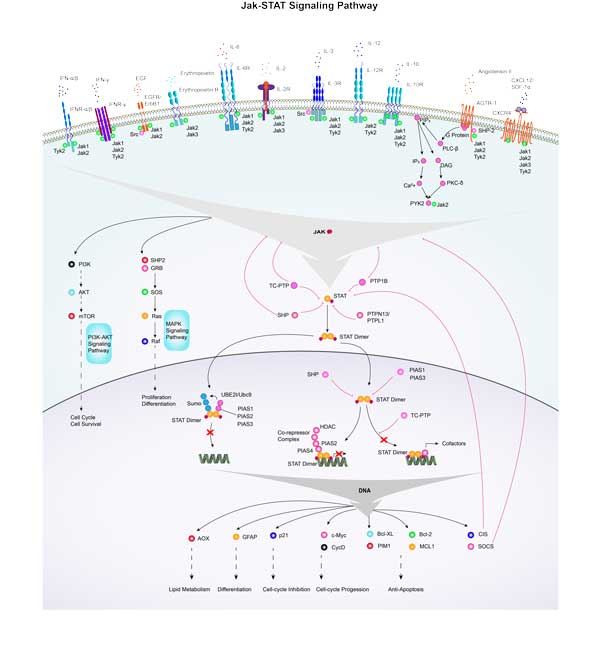HDAC6
-
Official Full Name
histone deacetylase 6 -
Overview
Histones play a critical role in transcriptional regulation, cell cycle progression, and developmental events. Histone acetylation/deacetylation alters chromosome structure and affects transcription factor access to DNA. The protein encoded by this gene belongs to class II of the histone deacetylase/acuc/apha family. It contains an internal duplication of two catalytic domains which appear to function independently of each other. This protein possesses histone deacetylase activity and represses transcription. [provided by RefSeq, Jul 2008] -
Synonyms
HDAC6;histone deacetylase 6;HD6;JM21;CPBHM
Recombinant Proteins
- Human
- Rat
- Mouse
- Rhesus macaque
- Dog
- Macaca fascicularis
- Pig
- E.coli
- Insect cells
- Insect Cell
- Sf9 Insect Cell
- HEK293 cells
- Mammalian Cell
- Wheat Germ
- HEK293
- Insect cell
- HEK293T
- Mammalian cells
- His
- GST
- Non
- His&T7
- Flag
- FLAG
- His&Fc&Avi
- Myc&DDK
- His&SUMO
Background
What is HDAC6 protein?
HDAC6 (histone deacetylase 6) gene is a protein coding gene which situated on the short arm of chromosome X at locus Xp11. The protein encoded by this gene belongs to class II of the histone deacetylase/acuc/apha family. It contains an internal duplication of two catalytic domains which appear to function independently of each other. This protein possesses histone deacetylase activity and represses transcription. The protein consisted of 1215 amino acids and is approximately 131.4 kDa.
What is the Function of HDAC6 protein?
The protein HDAC6 is a cytoplasmic enzyme that regulates many key biological processes. These processes include cell migration, immune synapse formation, viral infection, and the degradation of misfolded proteins. In addition, HDAC6 deacetylates tubulin, Hsp90, and actin, and can form complexes with other protein companions. In particular, HDAC6 can specifically catalyze non-histone substrates and participate in and regulate numerous physiological or pathological processes. While HDAC6 is a central component of the stress response that regulates SG formation and potentially contributes to control of RNA metabolism and translation.
HDAC6 Related Signaling Pathway
HDAC6 can participate in the occurrence and development of tumor by activating Ras signaling pathway, influencing cell cycle, inhibiting apoptosis, regulating cellular immunity and promoting the invasion and metastasis of cancer cells. In addition, HDAC6 plays a key role in inducing epithelial mesenchymal transformation (EMT) in the TGF-β signaling pathway, which is a key step in many types of cancer.
HDAC6 Related Diseases
Mutations in the HDAC6 gene are commonly associated with cardiovascular and inflammatory diseases. More seriously, HDAC6 are associated with X-Linked Dominant Chondrodysplasia. In addition, mutations in the HDAC6 gene are also associated with the occurrence and development of neurodegenerative diseases such as Alzheimer's disease and Parkinson's disease, breast cancer, colon cancer, lung cancer and many other cancers.

Fig1. Schematic model of HDAC6 regulating lung cancer cell growth.
Bioapplications of HDAC6
The modulation of HDAC6 activity holds potential for the development of novel therapeutic strategies across a range of diseases. HDAC6 inhibitors have shown promise in preclinical and clinical studies for the treatment of certain cancers, including multiple myeloma and lymphoma.
Case Study
Case Study 1: Ji Hyeon Lee, 2022

Fig1. qRT-PCR data are representative of three independent experiments.
Case Study 2: Guangying Xu, 2022

Fig2. HDAC6 protein expression in colon cancer and M2 macrophage infiltration in the microenvironment were evaluated using an mIHC platform (panel: CK/HDAC6/CD68/CD163).
Quality Guarantee
High Purity

Fig1. SDS-PAGE (HDAC6-4648H) (PROTOCOL for western blot)
.

Fig2. HTRF assay was used for detection. (HDAC6-400H)
Involved Pathway
HDAC6 involved in several pathways and played different roles in them. We selected most pathways HDAC6 participated on our site, such as Alcoholism,Assembly of the primary cilium,Cell cycle, which may be useful for your reference. Also, other proteins which involved in the same pathway with HDAC6 were listed below. Creative BioMart supplied nearly all the proteins listed, you can search them on our site.
| Pathway Name | Pathway Related Protein |
|---|---|
| Cellular response to heat stress | HSPA13,BAG5,HSPA14,HSPA7,ST13,KIAA1967,BAG3,RPS19BP1,DNAJC7,NUP50 |
| Assembly of the primary cilium | CDK5RAP2,DYNLRB1,EXOC1,KIFAP3A,NPHP3,IQCB1,CP110,B9D2,TNPO1,RAB3IP |
| Constitutive Signaling by NOTCH1 PEST Domain Mutants | HEYL,HEY1,HEY2,CDK8,ADAM10,JAG2,CCNC,JAG1,HDAC5,MIB1 |
| Disease | KPNA5,HDAC5,CPSF6,DOCK2,NUP35,FDXR,KREMEN1,WHSC2,PSIP1,AP1M2 |
| Alcoholism | CREB3,HIST1H2AP,ATF2,GNG10,HIST1H2AB,HIST1H2BA,PKIA,HIST1H4M,GNAO1,HIST1H2BJ |
| Cell cycle | MAD2L2,MIS12,SET,CCP110,PIANP,APITD1,TSGA14,KAT5,PRKDC,SYCE1 |
| Cellular responses to stress | CBX4,AMBRA1B,KIAA1967,HIST1H1D,H3F3D,ST13,C7orf59,AMBRA1,SUZ12,CDKN2B |
| Constitutive Signaling by NOTCH1 HD+PEST Domain Mutants | CDK8,MIB1,CCNC,HEYL,JAG2,HEY1,HEY2,JAG1,ADAM10,HDAC5 |

Fig2. Consequences of HDAC6 activity inhibition regulation through TubA treatment in DMD mice model.
Protein Function
HDAC6 has several biochemical functions, for example, Hsp90 protein binding,NAD-dependent histone deacetylase activity (H3-K14 specific),actin binding. Some of the functions are cooperated with other proteins, some of the functions could acted by HDAC6 itself. We selected most functions HDAC6 had, and list some proteins which have the same functions with HDAC6. You can find most of the proteins on our site.
| Function | Related Protein |
|---|---|
| protein binding | GAST,RPRD1B,CDK5,MITF,CTCFL,Trl,MINOS1,LDLRAD1,VPS45,SYTL1 |
| beta-catenin binding | CXADR,SOX17,RORA,APC,PTPRU,PSEN1,MED12L,SMAD3,CARM1,CDH24 |
| zinc ion binding | PJA2,CRIP1,ZKSCAN5,TCEA1,S100A8,DTNB,Adamts19,NRD1B,TRIM50,ZNF207 |
| misfolded protein binding | EDEM1,HSPA5,F12,SDF2L1,TOR1A,DNAJC10,CLU,DNAJB9,STUB1,DNAJC3 |
| ubiquitin protein ligase binding | PRKAR1A,TPI1,TRAF3,UBE2W,CDC34A,TMEM173,NAE1,DIO2,SPOP,CUL3A |
| tau protein binding | FKBP4,SERPINB1A,BIN1,SNCA,PPP2R2A,APOE,DYRK1A,AATF,S100B |
| enzyme binding | TSPAN33,DNM2,CRB2,PPP3CA,JUN,FAM84B,CD4,PARK2,AKIRIN2,HIF1A |
| histone deacetylase binding | XBP1,MAGEA1,RUNX2,CCND1,HIST1H1B,PKN1,MEF2A,PKN2,MYOCD,MECP2 |
| alpha-tubulin binding | ARL8B,ARL4C,OFD1,NCALD,INO80,BBS4,SPAST,CAV3,FAM110C,SERPINB1A |
Interacting Protein
HDAC6 has direct interactions with proteins and molecules. Those interactions were detected by several methods such as yeast two hybrid, co-IP, pull-down and so on. We selected proteins and molecules interacted with HDAC6 here. Most of them are supplied by our site. Hope this information will be useful for your research of HDAC6.
EGFR;UBC;CYLD;ADRBK1
HDAC6 Related Signal Pathway
Resources
Related Services
Related Products
References
- Noack, M; Leyk, J; et al. HDAC6 inhibition results in tau acetylation and modulates tau phosphorylation and degradation in oligodendrocytes. GLIA 62:535-547(2014).
- Bobrowicz, M; Dwojak, M; et al. HDAC6 INHIBITION AUGMENTS THE EFFICACY OF ANTI-CD20 MONOCLONAL ANTIBODIES BY UP-REGULATING CD20 LEVEL IN MALIGNANT B-CELLS. HAEMATOLOGICA 99:437-437(2014).




